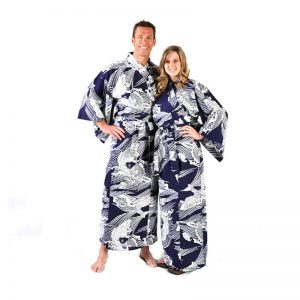Whether you’re a seasoned yukata enthusiast or simply exploring the world of Japanese robes, choosing the perfect yukata can be an exciting yet challenging endeavor. At Chopa, we offer two distinct collections of yukata—Standard and Premium. Each catering to different tastes, needs, and budgets. This guide will walk you through the features and differences between our Standard and Premium Yukata collections, helping you find the one that’s right for your lifestyle.
Features of Our Standard Yukata Collection
For those seeking a blend of affordability, style, and quality, the Standard Yukata collection is an excellent choice. Here’s what makes it special:
Material
- Woven from high-quality cotton, known as ‘hiraori’ in Japan.
- No fillers, simply 100% cotton for durability, comfort, and breathability.
Design and Dyes
- Each yukata showcases vibrant, timeless patterns with 6-8 dyeing processes.
- These fewer but bold dye applications result in striking contrasts, perfect for those who appreciate crisp and eye-catching designs.
Sizing and Fit
- Designed to suit wearers between 4’11” to 6’6″ (150cm to 200cm) in height.
- Adjustable fit to accommodate waist sizes from 15″ to 60″ (40cm to 150cm).
- Flexible adjustments ensure a comfortable tailored fit for all.
Ideal For
- First-time yukata buyers who want premium quality on a budget.
- Casual outings or relaxing at home, thanks to their easygoing and comfortable style.
With the Standard Yukata collection, you can celebrate Japanese tradition without stretching your budget. They’re perfect for introducing a touch of cultural flair to your wardrobe.
Features of Our Premium Yukata Collection
The Premium Yukata collection is for those who value exquisite craftsmanship and intricate detailing. Here’s why our deluxe yukata stands out:
Material
- Made with an upgraded cotton fabric, offering enhanced softness, durability, and airflow for ultimate comfort.
Vibrant and Detailed Designs
- Carefully created using 10-18 dye processes, these yukata feature stunningly intricate patterns with rich colors and fine details.
- Beautifully captures both the art and tradition of Japanese textile design.
Sizing and Fit
- Accommodates wearers of heights between 4’11” to 6’6″ (150cm to 200cm) with waist sizes ranging from 15″ to 60″ (40cm to 150cm).
- Adjustable in both length and waist, offering a fit worthy of premium attire.
Ideal For
- Yukata enthusiasts who value authentic craftsmanship and elevated artistry.
- Special occasions, cultural events, or simply making a statement.
A Premium Yukata isn’t just clothing; it’s a masterpiece of Japanese heritage, blending tradition with modern versatility.
Whether you’re looking for a comfortable casual option or a luxurious garment steeped in tradition, Chopa offers the perfect yukata for every occasion.
Why Choose Chopa?
- Expert Curation: Our selections are carefully curated for quality, authenticity, and style.
- Fast Shipping: Have your yukata delivered to your doorstep quickly and hassle-free.
- Free Shipping Over $75 in the USA: Enjoy perks that make your shopping experience even better.
- Support a USA-Owned Brand: We’re proud to serve our customers while celebrating Japanese culture.
Bring the Tradition of Yukata Into Your Life
Whether you’re drawn to the simplicity and affordability of our Standard Yukata collection or the exceptional detail and craftsmanship of our Premium Yukata, both options allow you to experience the rich heritage of Japanese robes.
Start your yukata journey today and elevate your wardrobe with a piece of timeless tradition. Shop the Collections Now.














